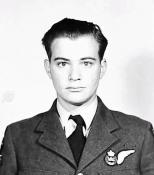
|
The King's School Canterbury |
Roll of Honour |
| Pilot Officer Alan Bruce DUNLOP (J/88861) | |
|
429 Squadron Royal Canadian Air Force Date of birth: 2nd August 1923 Date of death: 28th May 1944 Killed in action aged 20 Buried at Heverlee War Cemetery Plot 2 Row H Grave 8 |

|
| He was born at Victoria, British Columbia on the 2nd of August 1923 the son of Douglas Vernon Dunlop OKS and Phyllis Isobel (nee Gilbertson) of Burnt House, Pilgrim's Way, Charing and of Crofton, Victoria Island, British Columbia. He was educated at Duncan Public School from 1929 to 1935, at Brentwood College School, Victoria from 1935 to 1938 and at the King's School Canterbury where he was in Lattergate Waiting House and School House from September 1938 to July 1940. He served as a Private in the Officer Training Corps and was a member of the Rugby XV. On leaving school he returned to Canada where he worked as a loftsman's helper at Burrard Dry Docks at Vancouver from September to December 1941; while he was working he attended Baines Night School at Vancouver from September to November 1941. He was living at 2426 West 6th Avenue in Vancouver. He decided to enlist in the Royal Canadian Air Force and obtained a letter of support from the Reverend Stanley Poole of the King's School Canterbury which was dated the 27th of January 1942: - "Alan Dunlop left this school in July 1940 to go to Canada. His work at that time was very promising indeed and no doubt had he stayed here to complete his schooling he would by now have passed his School Certificate. He possessed considerable ability, much initiative, and great drive and energy. I consider that he would repay my confidence placed within him and I personally would recommend him for any post requiring courage and resource." He attended a medical examination on the 9th of March 1942 where it was recorded that he was five feet nine inches tall and that he weighed 145lbs. It was also recorded that he had a medium complexion, brown eyes and dark brown hair. The examining officer added these comments to his file: - "Has education in private school. Appears to be determined. Quiet, reserved type. Should do well in Aircrew." He enlisted as Aircraftsman 2nd Class R166599 in the Royal Canadian Air Force at the No. 1 Recruiting Centre, Vancouver on the 14th of May 1942 and was posted for basic training to No. 3 Depot, at Edmonton in Alberta. From the 20th of July 1942 he was posted to No. 2 Wireless School and was promoted to Leading Aircraftsman on the 20th of August 1942. He finished his course the 5th of February 1943 and was awarded his Wireless Operator's badge on the same day. He attended No. 8 Bombing and Gunnery School at Lethbridge, Alberta from the 8th of February to the 22nd of March 1943 where he qualified as an air gunner and passed out as 11th out of 26 in his class. He was promoted to temporary Sergeant on the 24th of March 1943 and was awarded his Air Gunner's badge on the same day. He attended No. 11 Radio School before being posted for further training to No. 22 Operational Training Unit on the 2nd of December 1943. He completed his course on the 24th of February 1944 where he was described by his Wing Commander as being: - "An average radio operator and a reliable type. Not recommended for a commission". He was posted to No. 61 Base and was commissioned as a Pilot Officer. He was posted to 429 based at RAF Leeming in Yorkshire. On the night of the 27th/28th of May 1944 Bomber Command despatched 331 aircraft, made up of 267 Halifaxes, 56 Lancasters and 8 Mosquitos, for an attack on an enemy military camp at Bourg Leopold, some fifty miles to the east of Antwerp in Belgium. This was in preparation for the forthcoming Allied invasion of Europe planned for June. Target markers were dropped into the centre of the camp and the bombers passed over the target at between 8,000 feet and 12,000 feet from where they dropped 1,191,000lbs of high explosive, causing severe damage to the facility. Alan Dunlop and his crew took off from RAF Leeming at 11.47pm on the 27th of May 1944 in Halifax Mk III MZ295 AL-Y for the operation. During the mission his aircraft collided in the air with Halifax Mk III LV831 ZL-P from 427 Squadron. Both machines crashed at Baisy-Thy (Brabant), 2 km south, south east of Genappe in Belgium at 2.30am. All members of both crews were killed and were buried at Baisy-Thy Communal Cemetery, but the 427 Squadron crew, and six of the 429 Squadron crew were later re-interred in the Heverlee War Cemetery, leaving Sergeant Kirton in his original grave at Baisy-Thy. The crew was:- Flight Sergeant Carmen Vincent Ross RCAF (Pilot) Sergeant Norman Hornby (Flight Engineer) Sergeant Elmer Lincoln Bailey RCAF (Navigator) Flying Officer Moses Rabovsky RCAF (Bomb Aimer) Pilot Officer Alan Bruce Dunlop RCAF (Wireless Operator/Air Gunner) Sergeant Paul Everett Coltman RCAF (Air Gunner) Sergeant Lloyd Kirton RCAF (Air Gunner) A memorial to both crews was unveiled at Baisy-Thy on the 5th of September 2004. |
|
| School House |
Back